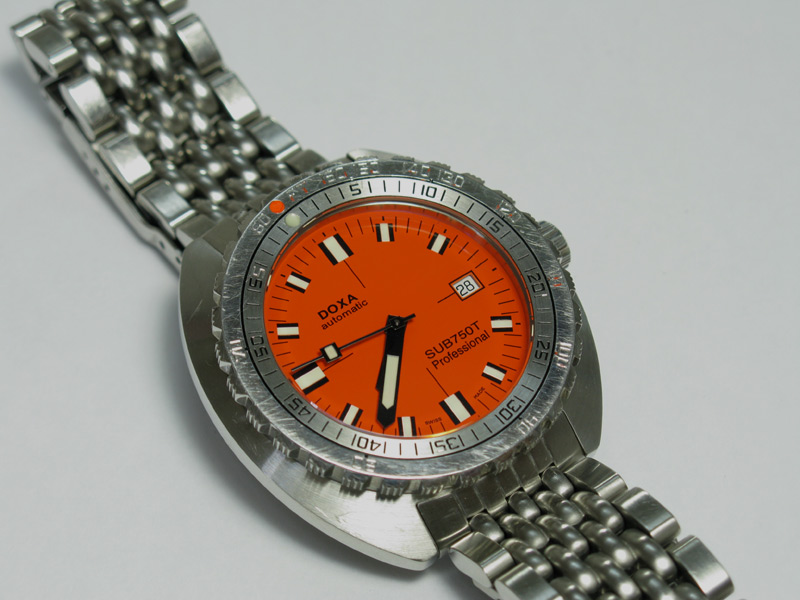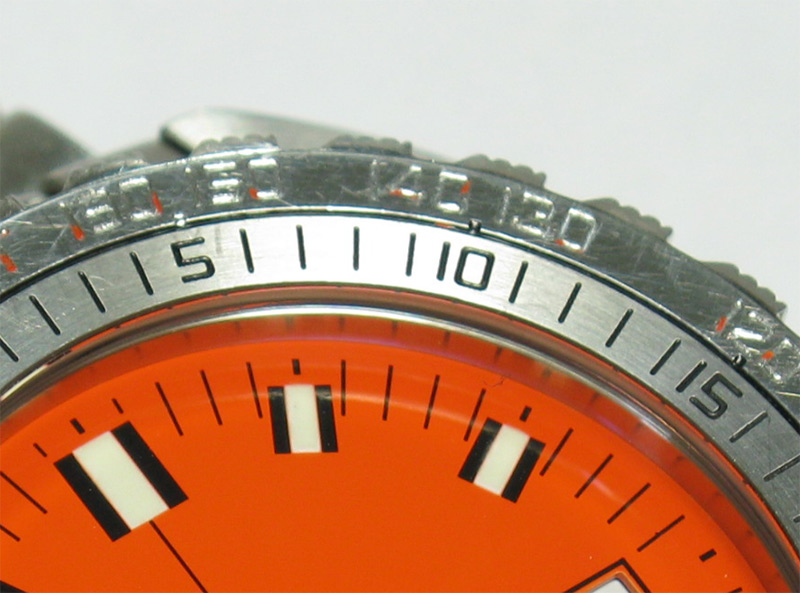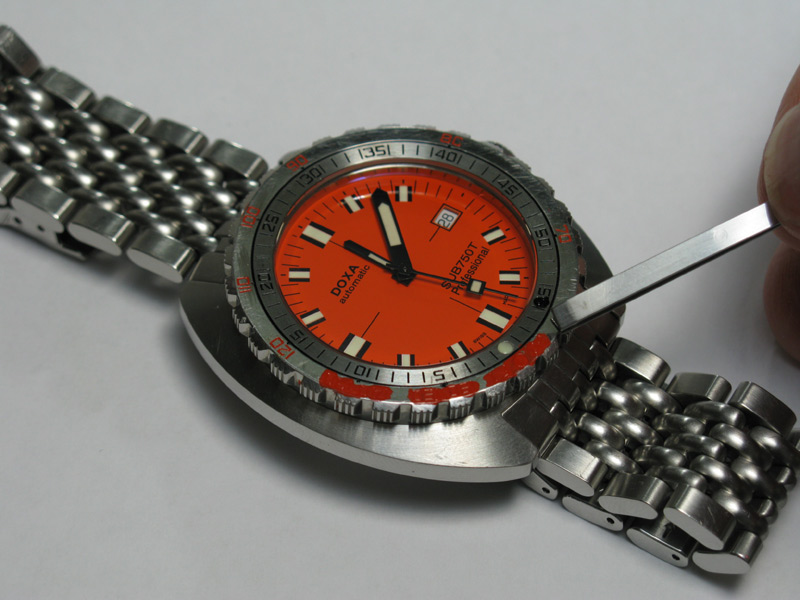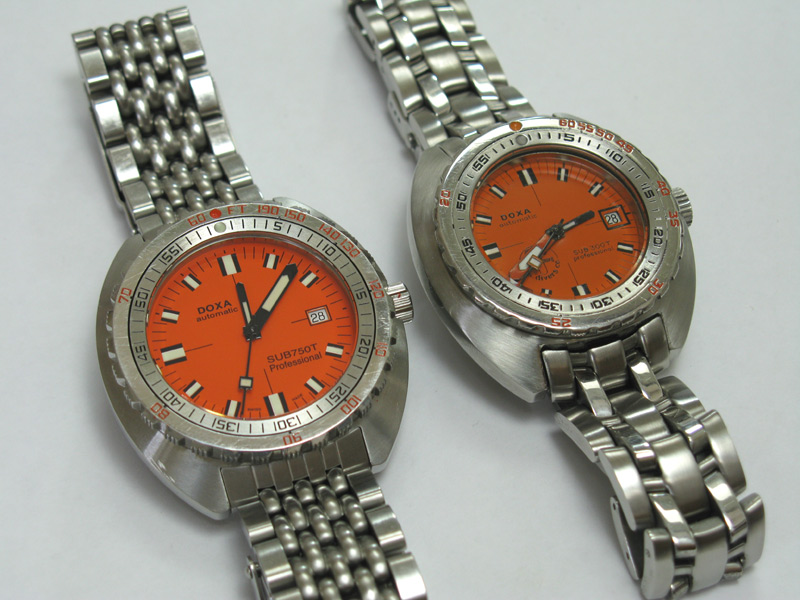
REPAINTING A BEZEL
© Dr. Peter McClean Millar - July 2008

The thing that makes Doxa SUB watches different from just about every other dive watch is the Non Decompression bezel. The bezel is a one piece affair with the US navy dive table stamped into the face. On the orange dial Professionals, the depth numbers are painted orange and the time is in black. The fact that the bezel is highly polished, it is inevitable that it will pick up scratches over a period of time. the above image shows my watch after around 3 years of wear. Even with numerous scratches, it still looks good. The paint is still intact and everything is clear and legible.

The above photo shows John Moors' watch. Same age and basically the same condition, however, the ink in the lettering is in poor condition. Many of the orange numbers have lost all of the paint and even some of the blacks ones are in the same condition. John has had the bezel repainted 3 times since he had it because the paint just doesn't seem to adhere. He sent it to me to have a look at and I thought it would be informative to show people how I repaint bezels.

The first thing I did was clean the watch. I use a soft, fine bristle toothbrush and ordinary washing up liquid. WARNING........, make sure that if you do this, that the winding crown is screwed fully in and that the caseback is tight. Kinda embarrassing to flood your dive watch in the sink!!!!

This is what the watch looked like after a good cleaning and it was when I really had a good look at the number indentations. The first thing that struck me when I got the watch out of the package John sent it in was that the indentations didn't seem very deep. Certainly not as deep as the vintage bezels I have restored. The close look after washing just confirmed this. I would normally polish the bezel to remove some of the light scratching but because the shallowness of the numbers I didn't even want to do that with this bezel.

Here is a close up of the bezel. Not the clearest of photos but it shows that there isn't much depth at all. Why is depth important? Well, the deeper the hole the more surface area the paint has to adhere to and hence the better chance it has for staying intact. John's bezel reminded me of the quartz Aqualung watches which occasionally turn up. They never have any paint left on the bezel because the depth of the numbers is very shallow and it is basically a waste of time trying to restore them.

The next thing to do is take a sharp pin or needle and trace out the numbers. This is to remove any debris or paint that may not have come out with washing and try to get as clean as surface as possible for the paint to adhere to.

Which type of paint to use? I use acrylic or enamel model paint. I have had great results with the orange paint seen in the photo. I don't know how good it would stand up to sea water immersion because I have only restored vintage bezels and I won't ever dive with them.
WARNING......... If the paint tin says shake for two minutes, shake it for three. If it says only paint on a dry surface, make it a very dry surface. Use a hair drier to dry it if necessary. But don't hold a hair drier close to a watch for any longer than five seconds at a time. They get very hot and you don't want to fry o-rings or dials. If the instructions say let the paint dry for twelve hours, leave it for twenty-four. My dad always talked about "horsing things on" but in this work, longer is better.

Now for the painting part. I use either a toothpick or a needle. It really doesn't matter which. This time I used a needle. I dipped the point into the paint and just carefully "rolled" the point and paint over the numbers. Don't worry if you put a big blob on the number. Clean the needle and just remove a bit. The paint will dry flat and fill into the number indentation. Where you have to be careful is not to get any into the black circle or little black dot below the orange numbers. No big deal if you do because when the paint is dry you can use a needle to scrape it out and just repaint that bit with black if the black paint comes out too.

And that's basically it for the painting. Just repeat the process for the black numbers and then leave the watch for twenty-four hours to dry and cure. Remember, longer is better....... no horsing it on.

Now for the tricky bit. When the paint is dry the excess has to be removed. What I use are the tweezers from a Swiss Army knife. I take the closed end of the tweezers and gently scrape the excess paint off the bezel. It comes off quite easily because there really isn't anything for it to adhere to unless there is a deep gouge on the bezel which it has got in to. As you come to the actual numbers themselves then what I do is actually scrape from the number to the edge or away from the number. Pressing and scraping at the same time. This tends to both remove the excess and press the paint into the number groove.
Usually it goes off without a hitch, however, sometimes a bit of the paint will come out. You can see that this has happened on the zero of the number eighty in the photo above. Don't worry about it. Just carry on with the rest and when finished, repaint that part and leave it another twenty-four hours.

When it is all finished, I use a soft cloth to remove any little bits of paint film that the edge of the tweezers didn't get. And that's basically all there is to it. The bezel is looking great again. The whole job takes one or two days. It's easy. You don't even need to have the eyes of a shit house rat or the hands of a London Underground pickpocket. Hell if I can do it, anybody can do it.

I'm sure there are better ways of doing it and maybe some "professionals" would poo-poo my technique. I can't guarantee the longevity of it, especially in seawater, but for my own daily use, the vintage watches I painted are still looking good a year after they were done. All I can suggest is give it a go yourself, if nothing else it is very satisfying to see the bezel coming up looking like new.